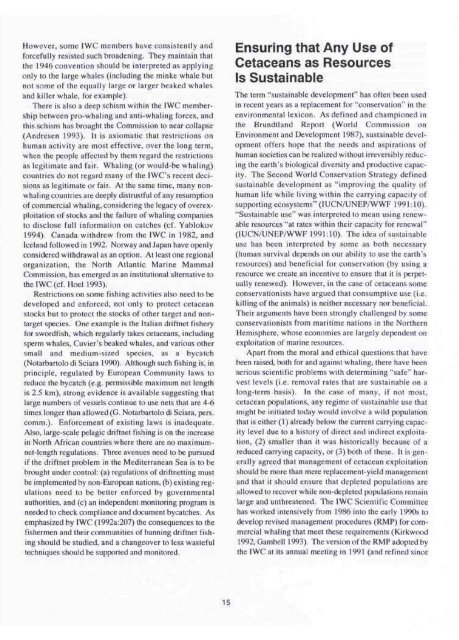Dolphins, Porpoises, and Whales - IUCN
Dolphins, Porpoises, and Whales - IUCN
Dolphins, Porpoises, and Whales - IUCN
Create successful ePaper yourself
Turn your PDF publications into a flip-book with our unique Google optimized e-Paper software.
However, some IWC members have consistently <strong>and</strong><br />
forcefully resisted such broadening. They maintain that<br />
the 1946 convention should be interpreted as applying<br />
only to the large whales (including the minke whale but<br />
not some of the equally large or larger beaked whales<br />
<strong>and</strong> killer whale, for example).<br />
There is also a deep schism within the IWC membership<br />
between pro-whaling <strong>and</strong> anti-whaling forces, <strong>and</strong><br />
this schism has brought the Commission to near collapse<br />
(Andresen 1993). It is axiomatic that restrictions on<br />
human activity are most effective, over the long term,<br />
when the people affected by them regard the restrictions<br />
as legitimate <strong>and</strong> fair. Whaling (or would-be whaling)<br />
countries do not regard many of the IWC's recent decisions<br />
as legitimate or fair. At the same time, many nonwhaling<br />
countries are deeply distrustful of any resumption<br />
of commercial whaling, considering the legacy of overexploitation<br />
of stocks <strong>and</strong> the failure of whaling companies<br />
to disclose full information on catches (cf. Yablokov<br />
1994). Canada withdrew from the IWC in 1982, <strong>and</strong><br />
Icel<strong>and</strong> followed in 1992. Norway <strong>and</strong> Japan have openly<br />
considered withdrawal as an option. At least one regional<br />
organization, the North Atlantic Marine Mammal<br />
Commission, has emerged as an institutional alternative to<br />
the IWC (cf.Hoel 1993).<br />
Restrictions on some fishing activities also need to be<br />
developed <strong>and</strong> enforced, not only to protect cetacean<br />
stocks but to protect the stocks of other target <strong>and</strong> nontarget<br />
sfjecies. One example is the Italian driftnet fishery<br />
for swordfish, which regularly takes cetaceans, including<br />
sperm whales, Cuvier's beaked whales, <strong>and</strong> various other<br />
small <strong>and</strong> medium-sized species, as a bycatch<br />
(Notarbartolo di Sciara 1990). Although such fishing is, in<br />
principle, regulated by European Community laws to<br />
reduce the bycatch (e.g. permissible maximum net length<br />
is 2.5 km), strong evidence is available suggesting that<br />
large numbers of vessels continue to use nets that are 4-6<br />
times longer than allowed (G. Notarbartolo di Sciara, pers.<br />
comm.). Enforcement of existing laws is inadequate.<br />
Also, large-scale fielagic driftnet fishing is on the increase<br />
in North African countries where there are no maximumnet-length<br />
regulations. Three avenues need to be pursued<br />
if the driftnet problem in the Mediterranean Sea is to be<br />
brought under control: (a) regulations of driftnetting must<br />
be implemented by non-European nations, (b) existing regulations<br />
need to be better enforced by governmental<br />
authorities, <strong>and</strong> (c) an independent monitoring program is<br />
needed to check compliance <strong>and</strong> document bycatches. As<br />
emphasized by IWC (1992a:207) the consequences to the<br />
fishermen <strong>and</strong> their communities of banning driftnet fishing<br />
should be studied, <strong>and</strong> a changeover to less wasteful<br />
techniques should be supported <strong>and</strong> monitored.<br />
15<br />
Ensuring that Any Use of<br />
Cetaceans as Resources<br />
Is Sustainable<br />
The term "sustainable development" has often been used<br />
in recent years as a replacement for "conservation" in the<br />
environmental lexicon. As defined <strong>and</strong> championed in<br />
the Brundtl<strong>and</strong> Report (World Commission on<br />
Environment <strong>and</strong> Development 1987), sustainable development<br />
offers hope that the needs <strong>and</strong> aspirations of<br />
human societies can be realized without irreversibly reducing<br />
the earth's biological diversity <strong>and</strong> productive capacity.<br />
The Second World Conservation Strategy defined<br />
sustainable development as "improving the quality of<br />
human life while living within the carrying capacity of<br />
supporting ecosystems" (lUCN/UNEP/WWF 1991:10).<br />
"Sustainable use" was interpreted to mean using renewable<br />
resources "at rates within their capacity for renewal"<br />
(lUCN/UNEP/WWF 1991:10). The idea of sustainable<br />
use has been interpreted by some as both necessary<br />
(human survival depends on our ability to use the earth's<br />
resources) <strong>and</strong> beneficial for conservation (by using a<br />
resource we create an incentive to ensure that it is perpetually<br />
renewed). However, in the case of cetaceans some<br />
conservationists have argued that consumptive use (i.e.<br />
killing of the animals) is neither necessary nor beneficial.<br />
Their arguments have been strongly challenged by some<br />
conservationists from maritime nations in the Northern<br />
Hemisphere, whose economies are largely dependent on<br />
exploitation of marine resources.<br />
Apart from the moral <strong>and</strong> ethical questions that have<br />
been raised, both for <strong>and</strong> against whaling, there have been<br />
serious scientific problems with determining "safe" harvest<br />
levels (i.e. removal rates that are sustainable on a<br />
long-term basis). In the case of many, if not most,<br />
cetacean populations, any regime of sustainable use that<br />
might be initiated today would involve a wild population<br />
that is either (1) already below the current carrying capacity<br />
level due to a history of direct <strong>and</strong> indirect exploitation,<br />
(2) smaller than it was historically because of a<br />
reduced carrying capacity, or (3) both of these. It is generally<br />
agreed that management of cetacean exploitation<br />
should be more than mere replacement-yield management<br />
<strong>and</strong> that it should ensure that depleted populations are<br />
allowed to recover while non-depleted populations remain<br />
large <strong>and</strong> unthreatened. The IWC Scientific Committee<br />
has worked intensively from 1986 into the early 1990s to<br />
develop revised management procedures (RMP) for commercial<br />
whaling that meet these requirements (Kirkwood<br />
1992, Gambell 1993). The version of the RMP adopted by<br />
the IWC at its annual meeting in 1991 (<strong>and</strong> refined since

















